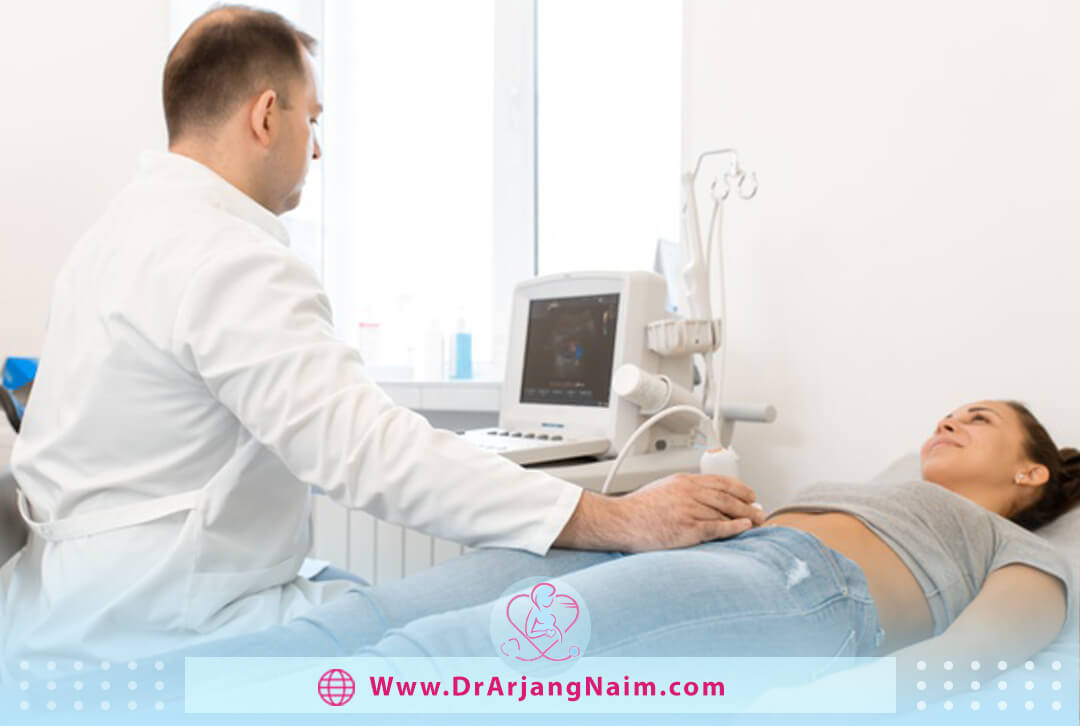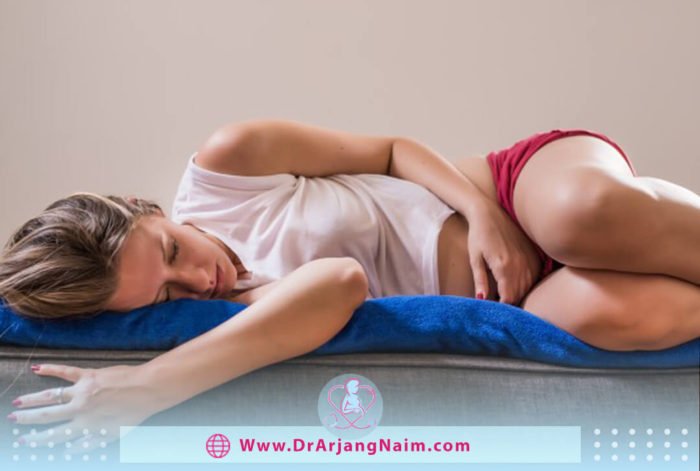Menstrual cramps (dysmenorrhea) are pain and cramps in the lower abdomen. Many women have menstrual cramps just before and during menstruation. For some women, this may cause some discomfort, but for some women, menstrual cramps can be so severe that they interfere with daily activities for several days. Causes of menstrual cramps include conditions such as endometriosis or uterine fibroids that cause abdominal pain during menstruation. Dysmenorrhea, not caused by another disease, decreases with age and often improves after delivery.
What are menstrual cramps?
Dysmenorrhea causes painful feelings that affect many women before and after menstruation. Menstrual cramps, also known as dysmenorrhea, or periodic pain, range from mild to severe. Menstrual muscle cramps begin when an egg is released from the ovaries and then passes through the fallopian tube. Pain occurs in the lower back and lower abdomen.
This condition usually starts 1 to 2 days before menstruation and lasts 2 to 4 days. Pain that is only associated with the menstrual process is known as primary dysmenorrhea. It is called secondary dysmenorrhea if it is caused by a recognizable medical problem such as endometriosis, uterine fibroids, or pelvic inflammatory disease.
Symptoms
Menstrual cramps usually refer to dull, throbbing, and cramping pain in the lower abdomen, just above the pelvis. Other symptoms may include:
- Pain in the lower back and thighs
- Nausea
- Vomiting
- Sweating
- Faintness
- Dizziness
- Diarrhea or loose stools
- Constipation
- Bloating
- Headaches
- Feeling of pressure in the abdomen
Causes
It is not always possible to diagnose the cause of painful menstrual periods. Some people are at greater risk for menstrual pain. These risks include:
- Being under the age of 20
- Having a family history of painful periods
- Smoking
- Having heavy bleeding with periods
- Having irregular periods
- Never having had a baby
- Reaching puberty before age 11
A prostaglandin hormone causes muscle contractions in the uterus that remove the lining. These contractions can cause pain and inflammation. Prostaglandin levels rise just before menstruation begins. Painful menstrual periods can be the result of an underlying disease.
Premenstrual syndrome (PMS)
It is a common disease that occurs in the body one to two weeks before the onset of menstruation. Symptoms usually go away after the start of bleeding.
Endometriosis
Endometriosis is a painful medical condition in which cells of the uterus lining grow in other parts of the body, usually in the fallopian tubes, ovaries, or pelvic lining.
Fibroids in the uterus
Fibroids are noncancerous tumors that can compress the uterus and cause abnormal menstruation and pain, although they often do not cause symptoms.
Pelvic inflammatory disease (PID)
PID is an infection of the uterus, fallopian tubes, or ovaries that is often caused by sexually transmitted bacteria and causes inflammation of the reproductive organs and pain.
Adenomyosis
Adenomyosis is a rare disease in which the lining of the uterus (endometrium) grows into the uterus’ muscular wall, causing inflammation, pressure, and pain. It can also cause longer or heavier periods.
Cervical stenosis
Cervical stenosis is a rare condition in which the cervix is so small or narrow that it slows the flow of menstruation and increases the pressure inside the uterus, resulting in more pain.
Diagnosis

The doctor will review medical history and perform a physical exam, including a pelvic exam. During a pelvic exam, the doctor will look for abnormalities in reproductive organs and look for infection signs. If the doctor suspects that a disorder is causing menstrual cramps, he or she may perform other tests.
Ultrasound
This test uses sound waves to create images of the uterus, cervix, fallopian tubes, and ovaries.
Other imaging tests
ACT or MRI scan is more detailed than ultrasound and can help the doctor diagnose underlying conditions. CT produces X-ray images taken from many angles and cross-sectional images of bones, organs, and other soft tissues inside the body.
MRI uses radio waves to produce accurate images of internal structures. Both tests are non-invasive and painless.
Laparoscopy
Although laparoscopy is not usually necessary to diagnose dysmenorrhea, laparoscopy can help diagnose an underlying condition such as endometriosis, adhesions, ovarian cysts, fibroids, and ectopic pregnancies. During this outpatient surgery, the doctor observes the abdominal cavity and reproductive organs by making small incisions in the abdomen and inserting an optical fiber tube with a small camera lens.
Complications
Menstrual cramps do not cause medical complications but can interfere with daily and social activities. On the other hand, some conditions related to painful menstruation can cause side effects. For example, endometriosis can cause fertility problems. The pelvic inflammatory disease may injure women’s fallopian tubes, increasing the risk of ectopic pregnancy.
When to call a doctor
If menstrual cramps interfere with your ability to do basic tasks each month, it’s time to talk to a gynecologist. Talk to a gynecologist about your symptoms, as well as if you have any of the following symptoms:
- Continuing pain after IUD placement
- At least three painful menstrual periods
- Passing blood clots
- Cramping accompanied by diarrhea and nausea
- Pelvic pain when not menstruating
An untreated infection can cause scar tissue that can damage the pelvic organs and lead to infertility. If you have symptoms of an infection, see a doctor right away:
- Fever
- Severe pelvic pain
- Sudden pain, especially if you may be pregnant
- Foul-smelling vaginal discharge
Treatment
To relieve menstrual cramps in women who suffer from this problem, the doctor may recommend the following:
- Pain relievers: Over-the-counter painkillers, such as ibuprofen or naproxen sodium, can help control pain in regular doses from the day before menstruation is expected to begin. Non-steroidal anti-inflammatory drugs (NSAIDs) are also available by prescription. Painkillers should be taken from the beginning of the period or as soon as the annoying symptoms start. Continue taking the medication as directed by the doctor or until the symptoms go away.
- Hormonal birth control: Oral contraceptive pills contain hormones that prevent ovulation, thus reducing the severity of menstrual cramps. These hormones are transferable in several ways. They can be inserted into the body through injections, skin patches, implants under the arm’s skin, the flexible ring inserted into the vagina, and an intrauterine device (IUD).
- Surgery: If menstrual cramps are caused by a disorder such as endometriosis or fibroids, surgery to correct the problem may reduce symptoms. If other methods cannot reduce the symptoms and the person does not intend to have children, surgical removal of the uterus may be a good option.
Home remedies to relieve menstrual pain

Muscle cramps affect many people before or during menstruation. While some people experience only mild muscle cramps, others experience more severe cramps. There are several ways to reduce dysmenorrhea.
Use a heat patch
Using a warm patch or pack on the abdomen can help relax the uterus muscles because the muscles cause pain. The heat can also boost blood flow to the abdomen, reducing pain. According to one study, using a heat pack for muscle cramps is more effective than taking over-the-counter painkillers such as acetaminophen.
Abdominal heat patches can be found at local and online pharmacies. They are straightforward to use. Just stick them on the belly. Electric heating pads and hot water bottles are not easily used as patches. But they are good options if you spend some time at home and do not need to move much.
Abdominal massage with essential oils
Massage of some essential oils can reduce menstrual cramps. Oils that seem to be more effective in reducing muscle cramps due to their ability to strengthen blood circulation are:
- Lavender
- Sage
- Rose
- Marjoram
- Cinnamon
- Clove
Rub a few drops of oil between your hands and then massage the abdomen in a circular motion for about 5 minutes; this movement will help reduce muscle cramps and strengthen blood circulation in the abdomen.
Exercise
Low to moderate-intensity aerobic exercise can help reduce the pain of menstrual cramps. Women who do 30 minutes of aerobic exercise three days a week for eight weeks show a significant reduction in menstrual cramps.
Soak in a tub
Immersion in a hot tub is another way to surround the pelvic floor muscles with the heat needed to relax. You can increase the pain-relieving power by adding a few drops of essential oil to the bathwater. Try to rest in a hot bath for at least 15 minutes to get the most out of it.
Yoga
Aerobic exercise such as yoga can help reduce menstrual cramps. Research has shown that women who take a 60-minute yoga class once a week for 12 weeks significantly reduce menstrual cramps.
Take supplements
Several studies have shown that different dietary supplements may help reduce menstrual cramps, although it is unclear exactly how they work. Some promising supplements are:
- Calcium
- Vitamins B-6
- Vitamins B-1
- Vitamins E
- Vitamins D
- Magnesium
- Zinc
- Vitamin B-12
- Fish oil
- Avoid caffeine and salty foods.
Although supplements can help reduce dysmenorrhea, it is best to avoid certain foods that cause water retention, bloating, and discomfort. Some foods that should be avoided include:
- Salty foods
- Caffeine
- Alcohol
- Fatty foods
- Stay hydrated
If a person becomes dehydrated during menstruation, abdominal cramps increase. It is recommended to consume eight glasses of water daily. If you have a lot of physical activity, you should increase the amount of water consumed.
Enjoy herbal teas
Herbal teas have anti-inflammatory properties and antispasmodic compounds that can reduce uterine muscle spasms that cause muscle cramps. Drinking chamomile, fennel, or ginger tea is an easy and natural way to relieve dysmenorrhea. Also, herbal teas can have other benefits, such as reducing stress and helping with insomnia.
Eat anti-inflammatory foods
Some foods can have a natural relief from muscle cramps and taste great. Anti-inflammatory foods can help blood flow and calm the uterus. Berries, tomatoes, pineapples, and spices such as turmeric, ginger, or garlic can help. Green leafy vegetables, walnuts, almonds, and fatty fish, such as salmon, can also reduce inflammation.
Reduce stress
Stress can make muscle cramps worse. Stress relief techniques such as meditation, deep breathing, yoga, or any other method that reduces stress can be used.
Practice good sleep hygiene
The quality of sleep affects menstrual symptoms and many health conditions. In one study, women with insomnia reported more severe dysmenorrhea and more interference with daily activities due to symptoms than women without insomnia.
How common are menstrual cramps?
Menstrual cramps affect about 84% of women, and among them, 25% of cramps are severe. A survey of teenage girls shows that more than 90% of them report menstrual cramps.
Prevention
Some of the methods that can help reduce dysmenorrhea include:
- Exercising regularly
- Trying to reduce stress
- Quitting smoking
The bottom line
Many people suffer from pain and contractions before the onset of menstrual bleeding or during menstruation; for some women, menstruation is a nightmare. A nightmare repeated every month with severe pain, lethargy, fatigue, nausea, headache, dizziness, and other discomforts, so many women are looking for ways to reduce menstrual pain. Different medications can help control pain and discomfort. Also, using strategies and lifestyle modifications can help reduce it.
See your doctor if you have severe or abnormal menstrual cramps or if the cramps last for more than two or three days. Whatever the cause of menstrual cramps, they can be treated, so it is important to check with your gynecologist.
Arjang Naim MD can provide the best treatment strategy by examining the patient’s condition and diagnosing the cause of pain.
Additional questions
- What do menstrual cramps indicate?
During a menstrual period, the uterus contracts to help expel its lining. Hormonal substances (prostaglandins) that play a role in pain and inflammation cause contraction of the uterine muscles. Higher levels of prostaglandins are associated with severe menstrual cramps.
2. What are the five stages of puberty?
- When hormones are hard at work behind the scenes
- When the first physical signs of puberty occur
- The growth spurt stage
- The continuation of development
- The final stage
3. What causes spinal stenosis?
- Bone overgrowth/arthritic spurs
- Bulging disks/herniated disk
- Thickened ligaments
- Spinal fractures and injuries
- Spinal cord cysts or tumors
- Congenital spinal stenosis
4. Why is laparoscopy done for infertility?
Laparoscopy for infertility is usually done only when other fertility tests have not led to a definitive diagnosis.
5. What are the top 10 inflammatory foods?
- Fruits such as strawberries, blueberries, cherries, and oranges
- Tomatoes
- Olive oil
- Green leafy vegetables
- Nuts
- Fatty fish
References
https://www.healthline.com/health/severe-menstrual-cramps#causes
https://www.healthpartners.com/blog/13-ways-to-stop-period-pain/
https://www.healthline.com/health/womens-health/how-to-get-rid-of-cramps#acupressure
https://www.onhealth.com/content/1/pms_symptoms_treatment
https://www.mayoclinic.org/diseases-conditions/menstrual-cramps/diagnosis-treatment/drc-20374944
https://www.webmd.com/women/menstrual-cramps
https://www.medicalnewstoday.com/articles/157333#takeaway
https://www.everydayhealth.com/pictures/reasons-your-period-might-painful/




